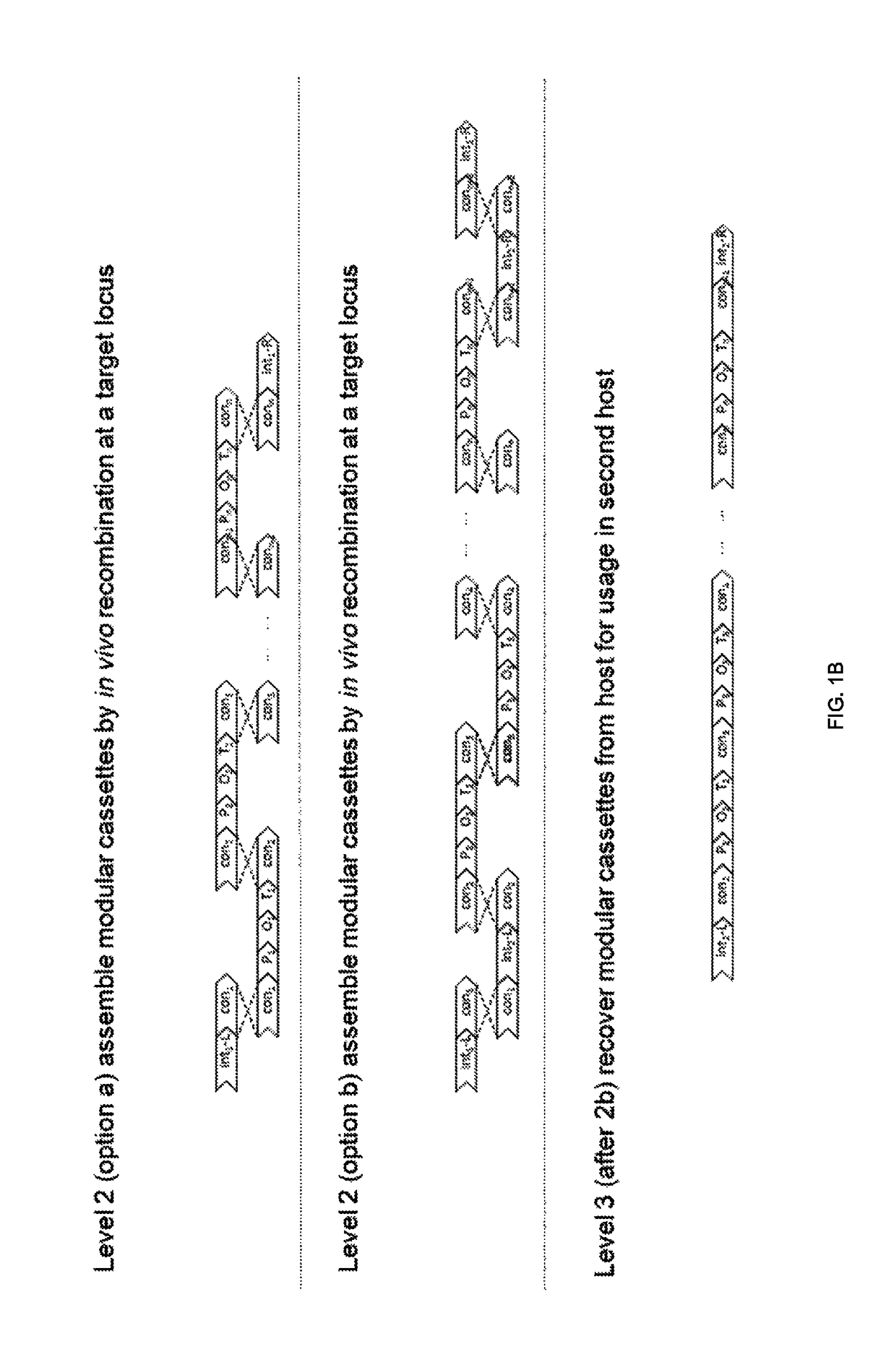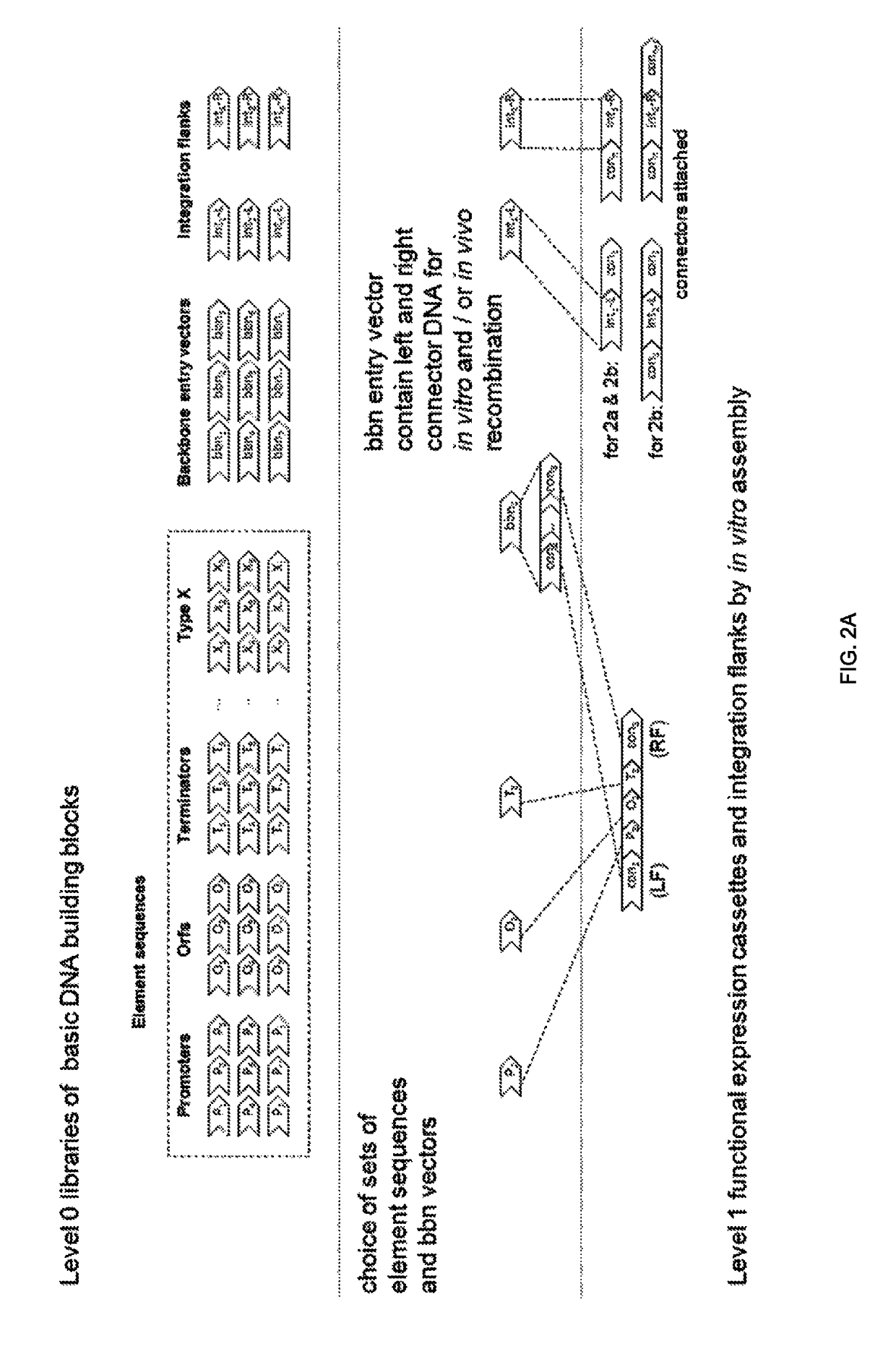Cloning method
a cloning method and expression cassette technology, applied in the field of cloning methods, can solve the problems of bottlenecks that still do not have appropriate solutions for every application, are rather complex methods, and are typically expensive processes
- Summary
- Abstract
- Description
- Claims
- Application Information
AI Technical Summary
Benefits of technology
Problems solved by technology
Method used
Image
Examples
example 1
Standardized Pathway Building System for Yeast
1.1 General Introduction to the Standardized Pathway Building System for Yeast
[0291]This method enables the fast introduction of genes / pathways with large flexibility into the yeast (S. cerevisiae) genome. Level One (see FIG. 9) is focused on cloning so-called standardized genetic elements, promoters, open reading frame's (ORF's) and terminators into functional expression cassettes flanked by standardized 50 bp connectors using a method called “Golden Gate Cloning” (Engler C. et al (2008) PLoS ONE 3(11): e3647 and Engler C. et al (2009) PLoS ONE 4 (5): e5553
[0292]The standardized 50 bp connectors are part of the backbone entry vectors and are used in Level Two (see FIG. 9) where the standardized 50 bp connectors provide the necessary homology between multiple expression cassettes, so that they to built up and integrated as pathways via in vivo homologous recombination into the yeast genome.
[0293]Standardization of the design of the desir...
example 2
Building a Metabolic Pathway for Itaconic Acid Production in Saccharomyces cerevisiae
2.1 Step 1: building the expression constructs from biobricks
[0345]As in Example 1, promoter, open reading frame and terminator are all separate DNA sequences designed according to the standard rules described in the patent. The sequences are synthesized and cloned by DNA2.0 in a standard cloning vector. The nucleotide sequences of SEQ ID NOs 120, 121, 122, 123, 124 and 125, all open reading frames, were specifically synthesized for the construction of the metabolic pathway for itaconic acid production in S. cerevisiae (see Table 5 and the sequence list for details). The open reading frames were used in golden gate reactions together with a set of the in Example 1 described promoters, terminators and backbone vectors thereby creating the cassettes as shown in Table 6. The formed expression cassettes (cassette 117, cassette 120, cassette 133, cassette 136, cassette 124 and cassette 126) were used as...
example 3
Standardized Pathway Building in Rasamsonia Emersonii
3.1 General Introduction to the Standardized Pathway Building System in Rasamsonia emersonii
[0359]This method enables the fast introduction of genes / pathways into the filamentous fungus Rasamsonia emersonii. Level 1 (see FIG. 9) is focused on cloning so-called standardized genetic elements, promoters, open reading frame's (ORF's) and terminators into functional expression cassettes using a method called “Golden Gate Cloning” (Engler C. et al (2008) PLoS ONE 3(11): e3647 and Engler C. et al (2009) PLoS ONE 4 (5): e5553. Assembly of multiple expression cassettes (Level 2) is performed using Gibson cloning (Gibson D G, Young L, Chuang R Y, Venter J C, Hutchison C A 3rd, Smith H O. (2009). “Enzymatic assembly of DNA molecules up to several hundred kilobases”. Nature Methods 6 (5): 343-345).
[0360]The multi cassette fragment was cloned in one of the two vectors of which the insert fragments together can be applied in the so-called “bi...
PUM
| Property | Measurement | Unit |
|---|---|---|
| volume | aaaaa | aaaaa |
| volume | aaaaa | aaaaa |
| diameter | aaaaa | aaaaa |
Abstract
Description
Claims
Application Information
 Login to View More
Login to View More - R&D
- Intellectual Property
- Life Sciences
- Materials
- Tech Scout
- Unparalleled Data Quality
- Higher Quality Content
- 60% Fewer Hallucinations
Browse by: Latest US Patents, China's latest patents, Technical Efficacy Thesaurus, Application Domain, Technology Topic, Popular Technical Reports.
© 2025 PatSnap. All rights reserved.Legal|Privacy policy|Modern Slavery Act Transparency Statement|Sitemap|About US| Contact US: help@patsnap.com



